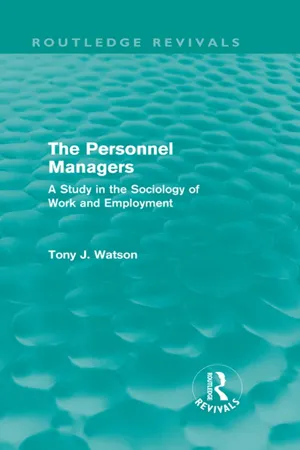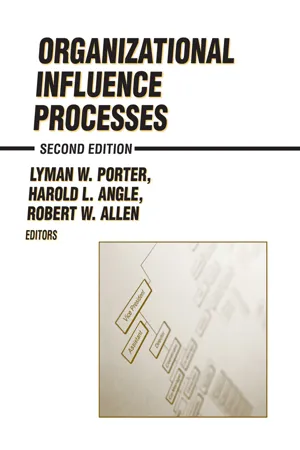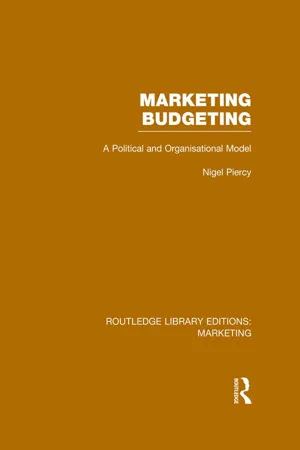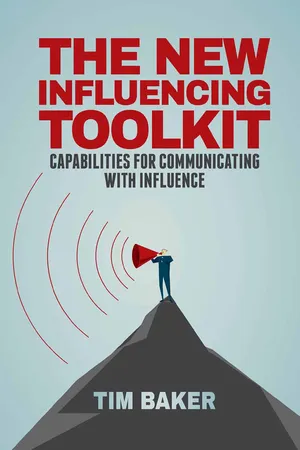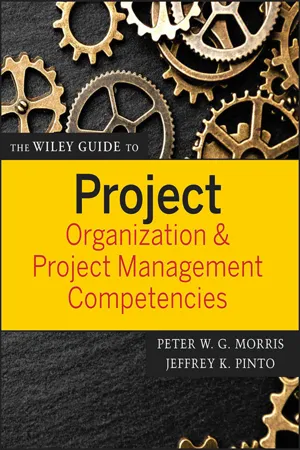Business
Impact of Power
The impact of power in business refers to the influence and control that individuals or groups have over decision-making, resources, and outcomes within an organization. It can shape organizational culture, decision-making processes, and employee behavior. Understanding and managing power dynamics is crucial for effective leadership, teamwork, and organizational success.
Written by Perlego with AI-assistance
Related key terms
6 Key excerpts on "Impact of Power"
- eBook - ePub
The Personnel Managers (Routledge Revivals)
A Study in the Sociology of Work and Employment
- Tony Watson(Author)
- 2013(Publication Date)
- Routledge(Publisher)
organisational society, with bureaucratic organisations of all types playing a major part in the power structures of such a society. Personnel specialists, by the nature of their work, operate within such organisations and therefore, before we can talk about the contribution that the occupation makes at the societal level, we have to consider the extent to which the members of the occupation have or might potentially have power or influence in the ways that organisations are run. Katz has commented that ‘power is one of the most disagreed about topics’ and it is true that `few people, including scholars, are able to agree on the nature and substance of power’ (1968, p. 66). Rather than reviewing the extensive debates which have occurred within sociology over this issue, I shall simply put forward my own conception of power – this being something that is implicit in the general theoretical scheme which has been utilised throughout this study.Power is the capacity that any group or individual possesses whereby the outcome of any situation can be affected in such a way that access is achieved or maintained to whatever resources are scarce and valued within a society or a part of that society. To have power is to have advantage relative to other competing or potentially competing groups or individuals.1 Since, within my theoretical perspective, the relationship between the individual and the organisation is one in which the individual makes contributions to the organisation’s functioning in return for which certain rewards are received, the power of a member of the organisation would be reflected in the extent of the rewards to which he has access (those being scarce and valued resources such as money, prestige, and autonomy2 - eBook - ePub
- Robert W. Allen, Lyman W. Porter, H.L. Angle(Authors)
- 2016(Publication Date)
- Routledge(Publisher)
Part 1 begins with a review of such topics as power, influence, and organizational politics, and it provides an overview of the study of these constructs, as that study has evolved. The readings in this section cite much of the most important literature on power and influence that has appeared over the past few decades and thus provide the interested reader with many worthwhile leads for further study. In these readings, there is a focus on factors that affect people’s choice of influence strategies. Also emphasized is the rather difficult cognitive challenge faced by someone who must analyze a situation in order to choose an appropriate influence strategy.Because Part 1 will provide a theoretical and historical basis for better understanding the material which will comprise the subject matter of Parts 2 through 4 , we recommend that Part 1 be read before any of those sections. Before discussing the readings in any more detail, we offer some background on the study of power and influence in organizations.POWER AND INFLUENCE
Power and influence are closely related concepts, but they are by no means synonymous. Power can be portrayed as a resource—a sort of reservoir of force—that can be used by an agent to change the behavior of another. The actual application of that force is what we mean by “influence.” Through the application of power, A has the capacity to influence B to behave in ways that s/he would otherwise not behave. As Hardy (1995, p. xiii) has pointed out, this rather simple notion has been “challenged, amended, critiqued, extended and rebuffed over the years, but nevertheless remains the starting point for a remarkably diverse body of literature.”The diversity in the literature to which Hardy refers extends well beyond the field of organization and management into sociology, political science, and the like. For our present purposes, however, we shall limit our treatment of power and organizational influence processes to literature sources that have been directed at an audience of managers and management scholars. Thus, the readings in this book have all been taken from journals and books that are primarily intended for a management audience.Even though power is a well-known reality in organizational life—for instance, Salancik and Pfeffer (1977) observed that managers asked to describe power distribution in organizations seem to have little trouble doing so—it tends to be a “messy” and elusive concept. While many aspects of power seem rational and public, there are also aspects that are more-or-less hidden beneath the visible surface. That is, along with the overt aspects of power and power relationships, there are some rather covert or symbolic aspects that do not, at first, meet the eye (Frost 1987). - eBook - ePub
Power in Business Relationships
Dynamics, Strategies and Internationalisation
- Dariusz Siemieniako, Maciej Mitręga, Hannu Makkonen, Gregor Pfajfar(Authors)
- 2022(Publication Date)
- Routledge(Publisher)
Overall, the review of B2B literature (i.e. supply chain and channel management) suggests that power is a very complex phenomenon that encompasses several dimensions/forms that may be grouped into two main categories: coercive and non-coercive. There is also a difference between power and power use, but a full understanding of power in inter-firm relationships requires employing the constructivists’ approach to power, i.e. incorporating its cultural/perceptual meaning. There is a need to employ the relativistic nature of the concept of power: inter-firm power is about the objective properties of the powerful party, as well as the other party’s perception of the influence (see Blois & Lacoste, 2009; Kähkönen & Lintukangas, 2011). This is especially true when it comes to the measurement of power in business-to-business relationships, which does not equal identification of objective differences in resource magnitude between business partners, especially different company size (Hopkinson & Blois, 2014). However, one should also take into consideration that not all power and power use is acknowledged by dominated actors, as ideological influences are usually based on spatial consensus and values dispersed among a large number of business actors. This, in turn, is linked to the need to sometimes look beyond the dyadic perspective, i.e. the relationship between a dominating customer/supplier and a dominated supplier/customer. Power can also be analysed in terms of the wider circumstances and indirect effects through which actor A has power over actor B via actor C. In this regard, in the multi-dimensional context of business relationships (Makkonen & Olkkonen, 2017), the perception and use of power can be based on elements that bind a dyadic relationship to a network of other actors, and can dictate the degree of dependence of the dyadic actors as well as the power present in the relationship.An interesting angle from which to analyse power is the cultural perspective, but not only in terms of the cultural or ideological influence of strong global organisations over smaller players, but also in terms of differences in national cultures with regard to power. In fact, claims that the acceptance of using different power tactics in business relationships may be culturally dependent appeared quite early in the literature, especially in international business research. For example, Johnson et al. (1993) found that in distribution channels, Western partners treat legitimate and referent power as non-aggressive power forms, while Japanese partners perceive them as rather aggressive. These results might not however be universal for all Asian countries. Lee (2001) provided evidence that Chinese distributors react negativelly to only coercive power use by other distribution channel members, while referent, expert, information, legitimate and reward power are treated as non-coercive, non-aggressive manifestations of power. According to Scheer et al. (2003), perceptions of injustice in the United States and the Netherlands are more tied to culturally influenced methods for measuring equity. Horak and Long (2018) proposed a harmonised use of coercive and non-coercive influence in supply chains composed of several tactics, but they suppose that some of these tactics may be very difficult to implement, e.g. paternalistic benevolence, as they can build very negative associations with regard to some social policies and values in the West. Looking at the equality movements dominating public discourse in Western countries, implementing “authority” tactics may also be problematic as it would assume that similar attention is paid to the value of competence and relationships alike across all supply chain connections. In general, - eBook - ePub
Marketing Budgeting (RLE Marketing)
A Political and Organisational Model
- Nigel Piercy(Author)
- 2014(Publication Date)
- Routledge(Publisher)
To review what has been uncovered about organisational power, it will be recalled that the starting point was to make the contrasts between the ubiquity of power and its relative neglect in the management literature; and between the general shared meaning of the term but the problems in technical definition. While variations in perspective were found, there would seem some consensus that a definition of power should account for: one actor infulencing the behaviour of another and thus organisational outcomes of various kinds; the use of coercion or overcoming resistance to some degree; and resource-dependence as the key to determining the existence of power. Power was distinguished from authority – broadly conceived as the formally delegated, sanctioned aspect of power, though this distinction is far from clear-cut – and similarly the term ‘influence’ was to some extent distinguished, although in this latter case the distinction appeared less fruitful and was not pursued.The review turned then from the question of what power is, to where it comes from, i.e. the bases and sources of power. The traditional paradigm of power bases describes types of power, but does not facilitate analysis of its sources. We turned therefore to consider separately the issues of: organisational structure as a source of power – both formal authority but also in terms of ‘domination’, status, information control, and so on – though recognising structure to be both a source and an outcome of power; uncertainty coping as a source of power, particularly as this was formulated in the ‘strategic contingencies’ theory of intraorganizational power’; dependence as a source of power, arising from differentiation and the structural division of labour, the location of uncertainty absorption, and other resource control; resources as a source of power, where those resources may be tangible or intangible; information as a power source, in the sense that information is one type of critical resource in organisations, which is subject to control and manipulation; the environment as a power source, or at least arbiter through creating uncertainties, influencing structure, and so on; and situational - eBook - ePub
The New Influencing Toolkit
Capabilities for Communicating with Influence
- T. Baker(Author)
- 2015(Publication Date)
- Palgrave Macmillan(Publisher)
How can a manager increase their power? All managers have three spheres of influence they need to exercise in organizations. They need to be able to influence their boss on a pretty regular basis. Managers also need to exercise influence over their colleagues in other departments from time-to-time. And finally, the majority of a manager’s time is taken up influencing their employees. The ability to exercise power and influence fittingly is the lifeblood of management. To understand what exercising appropriate managerial influence means, it might be useful to start with what it shouldn’t mean. It is not uncommon to consider influence or power as a form of manipulation. Some may think that by influencing people, we are exploiting them; getting them to do something by being deceptive or cunning, underhanded or tricky. As an extension of this idea, people of influence are oftentimes considered immoral or corrupt. This idea is not what The New Influencing Toolkit is about. I want to make that clear from the outset. Influence is defined in many ways. And the concept of influence has changed throughout the ages. AT THE COAL FACE. . . THE EVOLUTION OF INFLUENCE The word “influence” comes from the Medieval Latin word influential, stemming from the Latin word influere, which means “to flow”. In the late fourteenth century, an astrological connection continued with the word being defined as “streaming ethereal power from the stars acting upon character or destiny of men”. Later, in the fifteenth century, the word had evolved into a closer version of today’s definition: “exercise of personal power by human beings”. In the 1580s, the meaning became “exertion of unseen influence by persons” - Peter W. G. Morris, Jeffrey K. Pinto, Peter Morris, Jeffrey K. Pinto(Authors)
- 2010(Publication Date)
- Wiley(Publisher)
Television and radio advertisements, televangelists, and salespeople represent examples of some of the most common types of influence we experience on a daily basis. Note that in each case, the influencer cannot force your compliance. Each of us has the power to simply change the channel or leave the store if we are offended or threatened by the influencer’s message. How, then, do we explain the success that these people have in raising money and gaining sales? In a different context, how can we explain the success that some of our peers have in gaining compliance from other organizational members even though they have no direct authority over them? The answer to these questions typically focuses on the greater influencing ability that some of us possess relative to others. Because influence is a key component in organizational life, it is important to distinguish between influence and power. Many managers define power in terms of influence as a convenient shorthand. Even textbooks make the same definitional link—suggesting, for example, that power is the capacity to influence others. More appropriately, we can define influence as one person’s ability to get another to do something they want when there are no gross power differences between the two parties. That is, the influencer has no formal ability to “force” the other person to seek some goal or perform some task. From this definition, it is clear that there are some important similarities between power and influence: Both are used to change another’s behavior. We will see, however, that the two concepts are very different in some important ways while demonstrating that a thorough knowledge of influence tactics can be an important tool for better managing within the organization’s political climate. Table 5.2 demonstrates some of the key differences between power and influence
Index pages curate the most relevant extracts from our library of academic textbooks. They’ve been created using an in-house natural language model (NLM), each adding context and meaning to key research topics.
